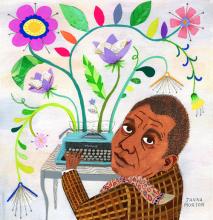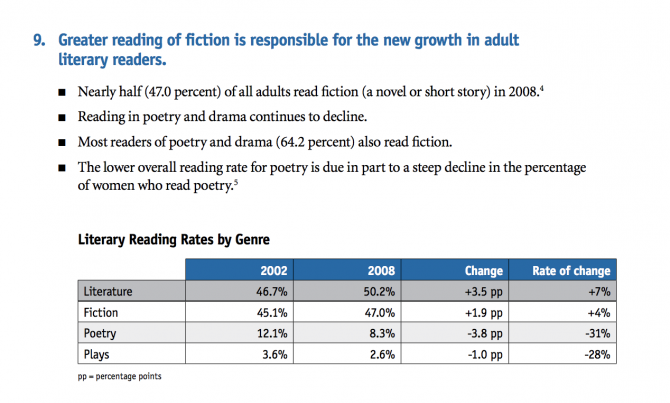Poetry Matters // The Case for Teaching Poetry in Every ELA Classroom (Part 1 of 2)
“The world changes according to the way people see it, and if you alter, even but a millimeter the way people look at reality, then you can change it.” ~James Baldwin

I can recall encountering this quote from the late James Baldwin in my earliest years as a teacher and feeling as though I had finally closed in on a meaningful rationale for reading and writing, one that transcended college and career readiness. At the heart of Baldwin’s assertion is a powerful assumption about language: that it can alter people’s perception of the world. As we enter into these early days of April, National Poetry Month, I’d like to reflect on the transformative power of poetic language, in particular. In addition to putting forth a few suggestions to guide the teaching of both poetry reading and poetry writing, I’d like to make a case for why poetry matters.
I realize that making a case for why poetry matters is somewhat countercultural in the face of current curricular norms. Literacy scholar Janet Alsup has argued that the prioritization of rational knowledge, along with an increasing obsession in US education with all things quantifiable, has resulted in the marginalization of literature. With the advent of the Common Core State Standards in 2011, for example, came a new ratio of recommended “text types,” calling for a 30 percent emphasis on literary fiction and nonfiction, and a 70 percent emphasis on informational text. Common Core author David Coleman claims that this construction lends itself more efficiently to students’ mastery of ideas. With these trends, it’s not surprising that the most recent Reading on the Rise report showed a decline in the US population’s reading of poetry and that the Common Core standards, while still deeming poetry reading a worthwhile exercise, make no mention of poetry writing.

To resist and counteract these curricular trends in US education, I could offer a litany of reasons why poetry matters. I could point to poetry’s ability to foster knowledge of genre, which is essential for anyone wishing to become a competent writer across context. I could expound upon the claims of scholars like Anthony Wilson who study the linguistic and cognitive demands that poetry places on students. But what I really wish to say to all of you reading and sharing this blog is that poetry matters not only for the sake of creating better readers and writers, but for the sake of creating better people who commune with others in and through language. Poetry carries with it a powerful invitation to awaken our sometimes far-too-anesthetized senses, to celebrate the significance of small details, and as I have argued elsewhere, to be more fully present to the people and experiences in our midst.
But “How?” you may wonder. “How does poetry do all these things?” I feel there are two avenues, in particular. Allow me to explain.
1. Distilling Language // Poetry has been described by others as “an economy of words.” In other words, a poem must say a lot, but in as few words as possible. Another way of describing poetry’s economy of words is to say that poets, as Francine Prose writes in her book Reading Like a Writer, “put every word on trial for its life.” In order for a text to function poetically, then, it must abide by the belief that words matter a great deal. To teach poetry, then–it is to teach people that language matters. It affects people. The connotation of words, the rhythm of words, the placement of words all matter—in poems, but also on playgrounds, in emails, and on the chains of text messages we exchange with family and friends.
2. Elevating Everyday Experience

In addition to its economy of words, poetry illuminates experience. It creates meaning, not by floating above the tastes and smells and sounds of everyday life, but by engaging with the concrete realities we experience on an everyday basis. Poet and teacher educator, Laura Apol, has noted that one of the common pitfalls of students struggling to write poetry is a tendency to dwell in abstractions “without providing any hooks on which to hang those abstractions.” She offers examples of poems gone wrong in a writing contest she was asked to judge, poems with lines like, “A true friend is always there/A true friend will always care” or “No one else seemed to care/I felt like I was all alone.” Successful poems, she notes, were those that “said something ‘big,” but “by attaching it to something ordinary” (e.g., a used box of children’s watercolor paints, a half-empty bottle of perfume, a child’s baseball mitt, a yellow crayon, a half-pound Hershey’s kill, a pair of dice) that we can see, taste, smell, or touch.
When students engage in the act of reading and writing poetry, they are essentially confronted with an invitation to awaken their senses, to seek out universal meaning in an otherwise mundane object or routine. If you want proof for this claim, check out “Wandering Around an Albuquerque Airport Terminal” by Naoimi Shahib Nye, and let me know if you’ll ever look at the nameless people next to you in an airport terminal quite the same way. The poet William Butler Yeats proclaimed, “The world is full of magical things, patiently waiting for our senses to grow sharper.” Poetry itself, I think, is the vehicle by which those senses grow sharper.
My answer to “Why poetry?” lends itself to a few suggestions for how to go about teaching poetry. In my second post on poetry, I will explain three ways that poetry can be implemented in teaching practice. Until then, let’s all make an effort to celebrate poetry and the careful attention to the world that the genre asks of us.
Happy Reading,
Kati

